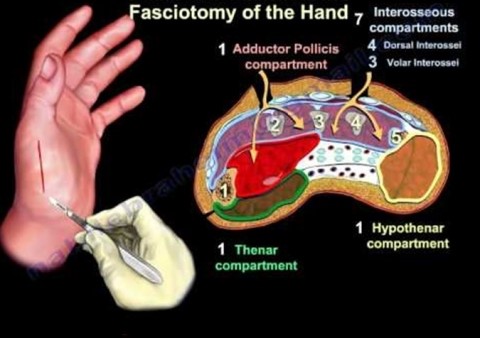

Following a severe injury, if an individual is showing signs of ACS, the individual should be taken to the emergency room right away for evaluation by a physician. It is critical that ACS is identified and treated immediately. Significant pain or an inability to bear weight throughout the involved limb Severe pain when the involved area is touched Severe pain with stretching of the involved muscle
#FOREARM COMPARTMENT SYNDROME TREATMENT FULL#
Severe pain in the involved limb that may be out of proportion to the typical response to a certain injuryĬhanges in sensation (tingling, burning, numbness)Ī sense that the limb is tight or full (from the swelling and increase in pressure) The most common signs and symptoms of ACS include: ACS most often develops in the lower leg and forearm.ĪCS is typically caused by a serious injury, such as:Ī direct hit or blow to the limb (athletics, a significant fall)Ĭrush injuries (motor vehicle accident, work-site injury) If left untreated for even a few hours, irreversible tissue damage can occur. It can develop as early as several hours following a severe injury. It is essential to relieve the pressure immediately to avoid permanent damage.Ĭompartment syndrome is typically classified into 2 categories- acute or chronic-based on its cause and symptoms.Īcute compartment syndrome (ACS) is a medical emergency. If the condition persists, the muscle and nerve tissue can be harmed. In rare circumstances, this condition can be more than our bodies can handle, and the blood supply to the area is restricted. However, when there is excessive swelling within a compartment due to a severe acute injury or chronic overuse, pressure builds within that compartment as the fascia does not expand to accommodate the increased volume. For example, our tissues may swell slightly after a hard workout or a mild injury. Our bodies are able to handle small changes in the pressure levels within these compartments.
_%C6ȿ%A1_%BFܻ%F3%C0%BB_%C0%D4%C0%BA_%B5%DA_%B9%ABô_%B0%AD%C7%D1_%C5%EB%C1%F5%C0%CC_%C0־%EE%BF%E4-2.jpg)
Each compartment is separated by fascia, a thick sheet-like tissue that does not stretch. Our limbs (arms and legs) are divided into compartments that contain different muscles, nerves, and blood vessels.


 0 kommentar(er)
0 kommentar(er)
